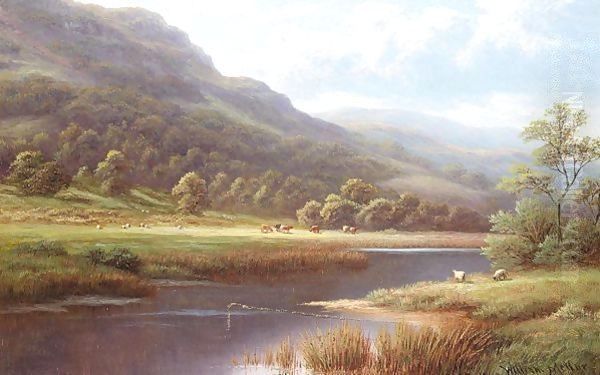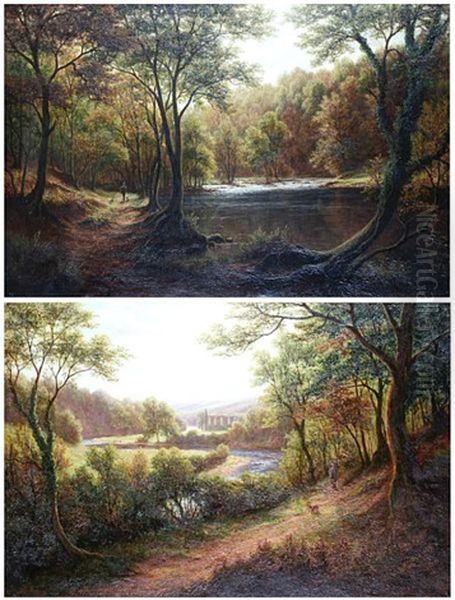
William Mellor stands as a significant figure within the rich tradition of British landscape painting. Active during the latter half of the 19th century and the early decades of the 20th, his life (1851-1931) spanned a period of considerable change both in society and the art world. A British national, born in the heart of Yorkshire, Mellor dedicated his artistic career to capturing the intricate beauty and serene atmosphere of the natural world, particularly the landscapes of Northern England and North Wales. His work, characterized by meticulous detail and a deep appreciation for the subtleties of light and season, offers a window into the idyllic, often romanticized, vision of the British countryside prevalent during his time.
Early Life and Artistic Formation
William Mellor was born in Barnsley, England, in 1851. His upbringing was steeped in art, a factor that undoubtedly shaped his future path. His father, Joseph Mellor, was himself an artist, providing young William with immediate exposure to the creative process and likely his earliest instruction. His mother, Mary Mellor, was also involved in artistic pursuits, fostering a home environment where visual arts were valued and practiced. This familial connection to art provided a foundation upon which William would build his own career.
Interestingly, Mellor's initial foray into the working world was not in art but in the burgeoning textile industry of the region, where he worked as a loom operator. This experience, common for many in industrial towns like Barnsley during that era, contrasts sharply with the tranquil, natural scenes he would later become famous for painting. The transition from the mechanical rhythms of the factory floor to the patient observation required for landscape painting marks a significant shift in his life's direction, suggesting a strong calling towards artistic expression.

The precise timeline of his transition from textile worker to full-time professional painter isn't definitively documented, but it's clear that he eventually embraced painting as his vocation. His father's influence is often noted, particularly in Mellor's earlier works, which some suggest leaned towards darker palettes and autumnal scenes, perhaps reflecting Joseph Mellor's own style. However, William soon developed his distinct artistic voice, one that celebrated the vibrancy and detail of the British landscape.
Artistic Style and Preferred Subjects
William Mellor's artistic identity is intrinsically linked to his detailed and affectionate portrayals of nature. He developed a highly recognizable style focused on capturing the lushness and tranquility of the British countryside. His primary sources of inspiration were the scenic regions of North Wales, the Lake District, and particularly the dales and river valleys of his native Yorkshire. He travelled extensively through these areas, seeking out picturesque locations that resonated with his artistic sensibilities.
A hallmark of Mellor's work is his preference for depicting scenes during the height of summer or the gentle transition of early autumn. This choice allowed him to explore the effects of bright, clear light on foliage, water, and terrain. His paintings often feature rivers winding through wooded valleys, serene lakes reflecting the sky, cascading waterfalls, and sun-dappled meadows. He possessed a remarkable ability to render the intricate details of leaves, bark, rocks, and water surfaces with meticulous care, giving his canvases a sense of immediacy and realism.
His technique involved careful observation and precise brushwork. He paid close attention to the play of light and shadow, using it to define form and create depth. The atmosphere in his paintings is typically one of peace and serenity, inviting the viewer to step into a world untouched by the industrialization rapidly changing other parts of Britain. This focus on natural beauty, rendered with clarity and detail, aligns his work with the broader currents of Naturalism and the enduring tradition of British landscape painting, following in the footsteps of earlier masters like John Constable, though with his own distinct Victorian sensibility.
The Landscapes of Yorkshire and Beyond
Yorkshire, Mellor's home county, featured prominently in his oeuvre. The Yorkshire Dales, with their characteristic stone walls, rolling hills, and sparkling rivers like the Wharfe, provided endless inspiration. Locations near Bolton Abbey and Barnard Castle appear frequently, captured with his signature attention to detail and atmospheric calm. His painting titled "Near Barnard Castle" is a testament to his engagement with this specific locale, likely depicting the River Tees or the surrounding woodlands near the historic castle ruins.

Beyond Yorkshire, Mellor was deeply drawn to the dramatic beauty of North Wales. The region's mountains, valleys, and rivers offered a different kind of landscape, perhaps wilder and more rugged than the Yorkshire Dales, yet Mellor rendered them with the same sensitivity to light and detail. His travels also took him frequently to the Lake District in Cumbria, another area renowned for its stunning natural beauty. His work "Rydal Lakes, Westmoreland" (Westmoreland being the historical county encompassing part of the Lake District) exemplifies his engagement with this region, known for its picturesque lakes and connections to the Romantic poets. The title itself underscores his practice of often identifying the specific location depicted, adding a topographical accuracy to his artistic interpretations.
Whether depicting the gentle flow of a Yorkshire river or the reflective surface of a Cumbrian lake, Mellor consistently sought to capture the essence of the place. His works are not merely topographical records; they are imbued with a sense of poetry and a romantic appreciation for the natural world. He excelled at portraying the textures of nature – the roughness of stone, the smoothness of water, the delicate complexity of summer foliage – creating immersive and inviting scenes.
Representative Works
Several works stand out as representative of William Mellor's style and subject matter. While a comprehensive catalogue is challenging to assemble due to his limited exhibition history in major public galleries, certain titles frequently appear in collections and auction records, highlighting his key themes.
"Near Barnard Castle" is one such example, firmly placing the viewer in the landscape of County Durham, bordering Yorkshire. Knowing Mellor's style, one can envision a scene featuring the River Tees, perhaps with the castle ruins subtly integrated into the background, framed by lush trees rendered with his characteristic detail. The focus would likely be on the play of sunlight on the water and surrounding foliage, evoking a sense of peaceful seclusion.
"Rydal Lakes, Westmoreland" transports the viewer to the heart of the English Lake District. This painting likely captures the serene beauty of Rydal Water or Grasmere, famous for their association with poet William Wordsworth. Mellor would have focused on the reflections in the still water, the surrounding fells, and the rich greenery of the lakeside vegetation, emphasizing the tranquil atmosphere that has drawn artists and writers to the area for centuries. The mention in one source of it being a "Scottish landscape painting" seems geographically inaccurate, as Rydal is firmly in England; it might be a descriptive part of a specific auction title or a minor error in the source data.

The pair of paintings titled "The Kingfisher's Pool and Fishing in Peaceful Waters" encapsulates Mellor's interest in riverine scenes and the quietude of nature. "The Kingfisher's Pool" suggests an intimate nook along a riverbank, perhaps shaded by trees, where the vibrant flash of a kingfisher might be seen – a detail appealing to the Victorian love of nature's specifics. "Fishing in Peaceful Waters" likely portrays a broader view of a calm river or lake, possibly with a solitary angler, emphasizing the harmony between human activity (leisurely fishing) and the natural environment. Together, these titles suggest works celebrating the gentle beauty and recreational pleasures found in Britain's waterways.
These examples illustrate Mellor's consistent focus on specific, identifiable locations within Britain, rendered with a detailed realism that celebrates the beauty of the natural world, particularly its waterways and woodlands, during the most verdant times of the year.
Context within British Art
To fully appreciate William Mellor's contribution, it's helpful to place him within the context of late 19th and early 20th-century British art. This was a period of diverse artistic exploration. While Mellor adhered to a relatively traditional style of landscape painting, other movements were gaining traction. The influence of the Pre-Raphaelite Brotherhood, with members like Dante Gabriel Rossetti, John Everett Millais, and William Holman Hunt, had emphasized detailed observation of nature earlier in the century, which resonated with the Victorian appreciation for meticulous rendering seen in Mellor's work, even if his subjects were purely landscape.
Mellor worked during a time when landscape painting remained highly popular with the public and collectors. He was a contemporary of other successful landscape artists such as Benjamin Williams Leader, known for his picturesque views of the English and Welsh countryside, often featuring silver birches and tranquil rivers, stylistically comparable in some respects to Mellor. Alfred de Bréanski Sr. also painted dramatic landscapes, particularly of Scotland and Wales, often with a more heightened sense of romanticism than Mellor.
While Mellor focused on idyllic rural scenes, other contemporaries like John Atkinson Grimshaw gained fame for their atmospheric nocturnes and depictions of gaslit urban docks and streets, offering a different perspective on the Victorian environment. Watercolourists like Myles Birket Foster captured detailed and often sentimental scenes of rural life and landscape, sharing Mellor's focus on the countryside's charm. George Vicat Cole was another popular landscape painter known for his harvest scenes and views of the Thames.
Mellor's dedication to detailed naturalism can be seen as a continuation of the legacy established by John Constable and J.M.W. Turner earlier in the century, albeit adapted to Victorian tastes, generally favouring calmer, more detailed scenes over the sublime or atmospheric drama often explored by Turner. He worked alongside, but seemingly remained separate from, emerging trends like British Impressionism, championed by artists associated with the Newlyn School like Stanhope Forbes and Walter Langley, who focused more on capturing fleeting effects of light and often depicted coastal life and social realism, or figures like Philip Wilson Steer who engaged more directly with French Impressionist techniques. Mellor remained committed to his established style, finding a ready audience for his beautifully crafted, reassuring visions of nature.
Exhibition, Reception, and Legacy
Information suggests that William Mellor did not frequently exhibit his works in the major London art institutions like the Royal Academy. This might indicate that he primarily catered to a regional market or sold his work directly through dealers and galleries outside the capital. Despite this apparent lack of engagement with the London exhibition circuit, his paintings were, and continue to be, appreciated by collectors. His works appear regularly on the art market, particularly at auction, indicating a sustained interest in his particular brand of landscape painting.
His reception during his lifetime likely positioned him as a competent and reliable painter of attractive British scenery. The meticulous detail, appealing subject matter, and the common practice of titling his works with specific locations would have made his paintings desirable for those wishing to own a recognizable and beautifully rendered view of a beloved part of the country. He offered an escape into a seemingly timeless, peaceful rural world, an appealing prospect during a period of rapid industrial and social change.
William Mellor's legacy lies in his contribution to the extensive catalogue of British landscape art. He was not an innovator in the sense of pioneering new styles or movements, but rather a dedicated practitioner who excelled within the established tradition of detailed naturalistic landscape painting. His artistic significance rests on his ability to consistently produce high-quality, evocative depictions of the landscapes he knew and loved, particularly those of Northern England and Wales.
He remains known for his specific focus on summer and early autumn scenes, his mastery in depicting foliage and water, and the pervasive sense of tranquility that defines his work. For collectors and enthusiasts of traditional British landscape art, Mellor's paintings offer enduring charm and a skillful representation of the nation's natural beauty as perceived through a late Victorian and Edwardian lens. His work serves as a visual record of these landscapes and reflects the artistic tastes and appreciation for nature prevalent during his era.
Conclusion
William Mellor (1851-1931) carved a distinct niche for himself within the world of British art as a dedicated landscape painter. Born into an artistic family in Barnsley, he transitioned from industry to art, focusing his talents on capturing the serene beauty of the British countryside, especially in Yorkshire, the Lake District, and North Wales. Influenced by his father, Joseph Mellor, he developed a meticulous style characterized by detailed renderings of nature, particularly during summer and early autumn, emphasizing tranquil rivers, lakes, and woodlands. While not a participant in major avant-garde movements, he stood as a skilled practitioner within the popular tradition of naturalistic landscape painting, contemporary to artists like Benjamin Williams Leader and Alfred de Bréanski Sr., and working in a different vein from innovators like the Pre-Raphaelites or later British Impressionists. Though perhaps not widely exhibited in London's premier venues, his works, such as "Near Barnard Castle" and "Rydal Lakes, Westmoreland," found favour with collectors and continue to be appreciated for their craftsmanship and evocative portrayal of a peaceful, idyllic Britain. Mellor's legacy is that of a consistent and talented chronicler of specific British landscapes, whose work offers a lasting window onto the natural beauty celebrated in late Victorian and Edwardian art.